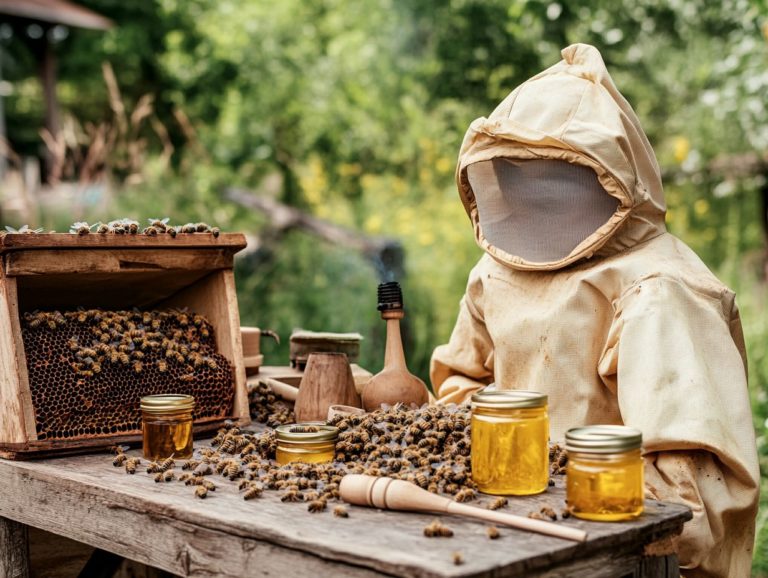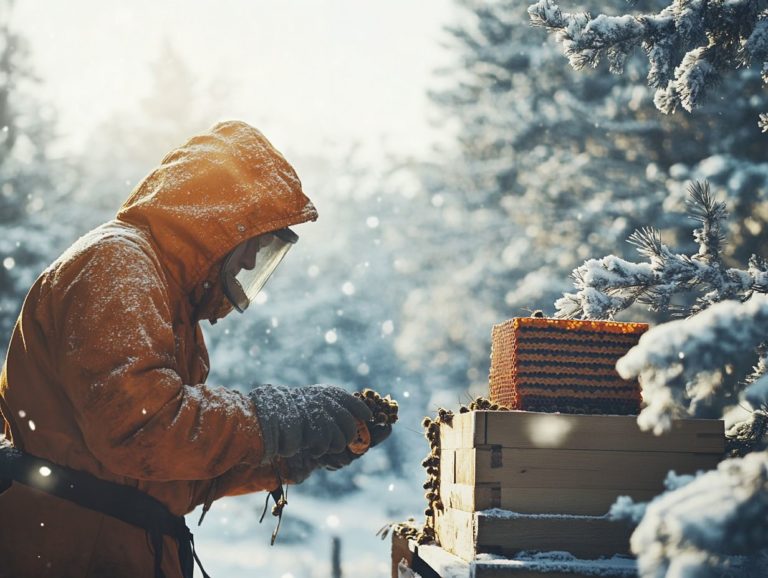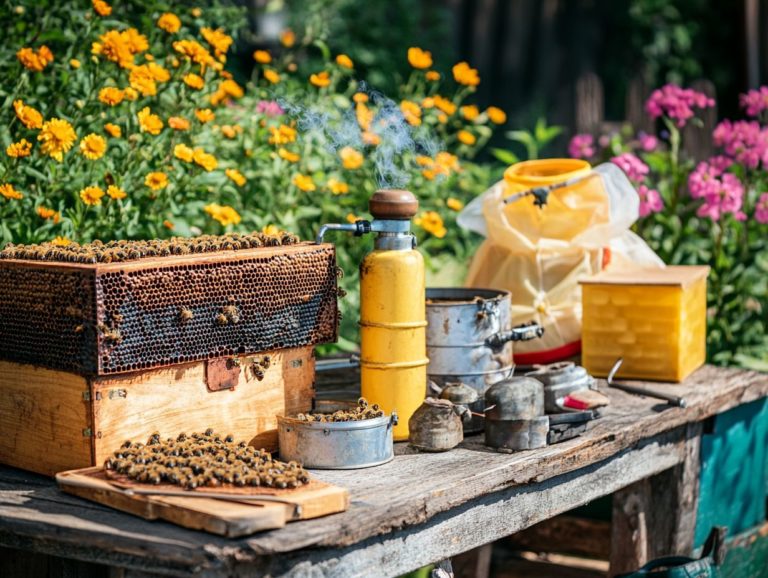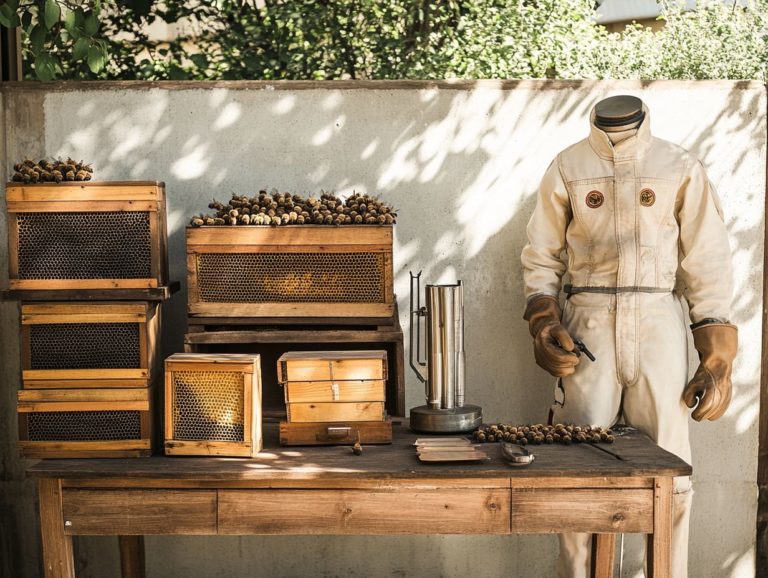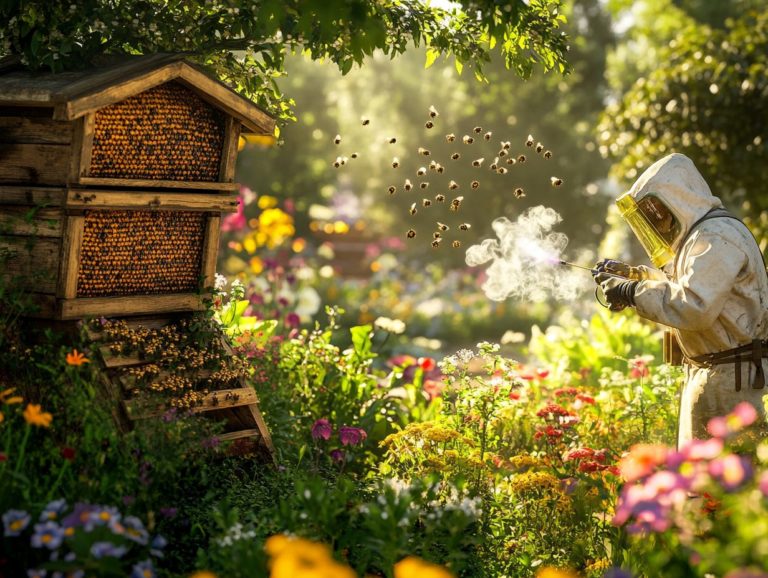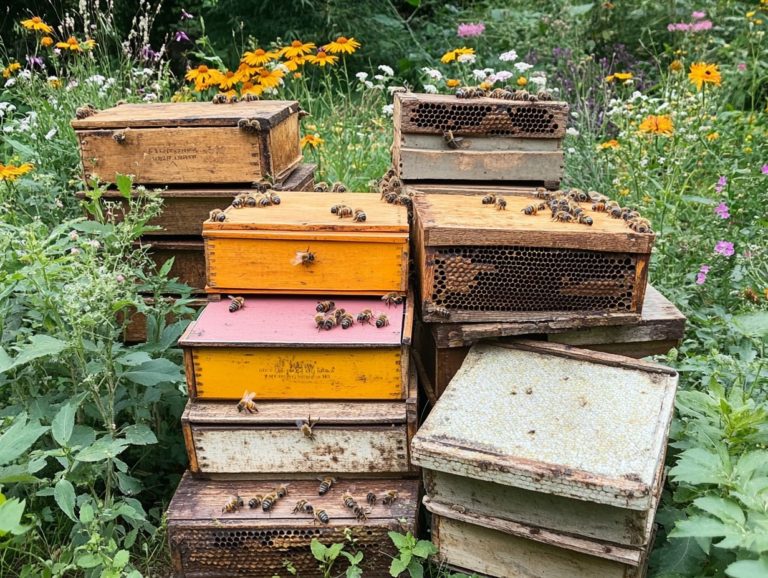How to Choose the Right Beekeeping Mask
When it comes to beekeeping, your safety and comfort are of utmost importance. Selecting the right mask is essential for protecting yourself from stings while enabling you to work efficiently, alongside other beekeeping equipment like a smoker tool and a bee brush.
Let s explore the various types of beekeeping masks available, ranging from simple veils to full suits. We will highlight key features you should consider, such as the material, visibility, and additional protective clothing.
You will also find essential safety precautions and tips for selecting the perfect size to meet your needs.
Whether you re a seasoned apiarist or an inquisitive beginner, this guide is designed to equip you with the knowledge you need to make an informed choice for your beekeeping endeavors, including tips on beekeeping safety and managing varroa mites.
Contents
- Key Takeaways:
- What Types of Beekeeping Masks Are Available?
- What Are the Features to Consider When Choosing a Beekeeping Mask?
- What Are the Safety Precautions When Wearing a Beekeeping Mask?
- How to Choose the Right Size Beekeeping Mask?
- What Are the Best Materials for a Beekeeping Mask?
- Frequently Asked Questions
- What should I consider when choosing my beekeeping gear?
- Which type of beekeeping mask and starter kits are best for beginners?
- Do I need to wear a beekeeping mask and other protective clothing if I am just checking on my beehive?
- What level of protection does a beekeeping mask provide?
- Should I choose a beekeeping mask with a plastic or wire frame, and what about respirators?
- How do I ensure the best fit for my beekeeping mask and other protective equipment?
Key Takeaways:

- Choose a beekeeping mask that suits your comfort and protection needs, such as veils for minimal coverage or full suits for maximum protection. Consider using a beekeeper respirator for added respiratory protection.
- Consider the material, visibility, ventilation, and comfort of a beekeeping mask before purchasing. Remember that the best choices are often part of a beekeeping starter kit.
- Ensure safety by finding the right size, properly securing the mask, and regularly cleaning and maintaining it.
- Act now to ensure your safety with the right beekeeping gear!
What Types of Beekeeping Masks Are Available?
In the realm of beekeeping, safety is paramount. Selecting the right beekeeping mask is a crucial component of your protective gear, whether you re just starting out or already a seasoned pro.
There s a diverse array of beekeeping masks available, each crafted to provide varying levels of protection against bee stings while maintaining visibility and comfort during your hive inspections. Make sure your protective clothing includes a full face mask and beekeeping gloves.
This guide delves into the different types of beekeeping masks, from veils and round hats to fencing veils and full suits. We will highlight their features and benefits so you can make an informed choice that enhances your beekeeping experience.
Consider using a hive tool and oxalic acid to treat varroa mites.
1. Veils
Beekeeping veils are your lightweight armor against bee stings, expertly crafted to protect your face and neck while ensuring you enjoy excellent visibility as you manage your hives.
These must-have gear pieces provide you with a comfortable and unobstructed view, which is crucial for the precision you need when working with your bees. Compared to other masks, veils typically offer superior ventilation, allowing you to breathe easily even during longer sessions in the apiary.
For added safety, consider using a 3M respirator with appropriate respirator filters. With a design that often features a brim or hood, these veils stay securely in place, minimizing the risk of accidental exposure.
Many veils also come equipped with handy hidden pockets for your essential tools, enhancing both safety and convenience. As a cornerstone of your beekeeping toolkit, veils integrate seamlessly with other equipment like gloves and hive tools, making them critical whether you’re just starting out or have years of experience under your belt.
2. Round Hats
Round hats are an excellent choice for beekeeping, offering you a blend of comfort and practicality while exuding a touch of style as you work with honeybees.
These hats are indispensable beekeeping essentials for both beginning beekeepers and seasoned pros. They are thoughtfully designed to provide enhanced ventilation and protection essential features for anyone navigating their hives.
The wide brims expertly shield your face and neck from both the sun’s rays and pesky bee stings, ensuring a safer and more enjoyable experience during those long hours spent in the apiary.
Crafted from lightweight materials, round hats prioritize your comfort, allowing you to wear them all day without experiencing strain or heat buildup. This is crucial when dealing with the unpredictable nature of bees, where maintaining optimal visibility alongside effective protective gear is key to ensuring your safety and enhancing your overall workflow.
3. Fencing Veils
Fencing veils offer you robust protection. They are designed to shield your face and neck from bee stings. These veils are ideal for beekeepers who prioritize safety during hive inspections.
These protective accessories are made from fine mesh materials, which keep insects at bay while ensuring clear visibility and comfort. Their unique design allows for ample airflow, helping you stay cool during long beekeeping tasks.
Fencing veils are especially valuable during peak foraging times when bees may be more aggressive. They provide peace of mind as you work closely with your hives. By adding these veils to your beekeeping gear, you enhance your safety level, letting you focus on your work without worrying about stings. Remember, a smoker tool calms bees by producing smoke, which can be helpful during these times.
4. Full Suits
Full beekeeping suits provide complete protection from bee stings, covering your whole body. They offer peace of mind whether you re a novice or a seasoned beekeeper.
These suits are made from durable, breathable materials, ensuring comfort during long hours in the apiary. They allow you to move freely while working with your bees. Unlike face masks or partial gear that may leave you vulnerable, a full suit acts as an encompassing shield, greatly lowering sting risks.
When handling aggressive bee colonies or conducting hive inspections, wearing a full suit is often your best bet. It reduces vulnerabilities, helping you stay focused on the task at hand. That extra layer of fabric can boost your confidence, enabling you to manage the hive s health and productivity. For advanced safety, consider using a beekeeper respirator like the X-plore 3300 for added respiratory protection.
What Are the Features to Consider When Choosing a Beekeeping Mask?
Choosing the right beekeeping mask is vital for your safety and comfort while working with honeybees. Pay close attention to key features like material, visibility, ventilation (how air flows through the mask), and comfort. These elements will greatly enhance your beekeeping experience.
Each factor is essential for providing protection against bee stings while allowing you to carry out hive inspections effectively, all without compromising your safety.
1. Material
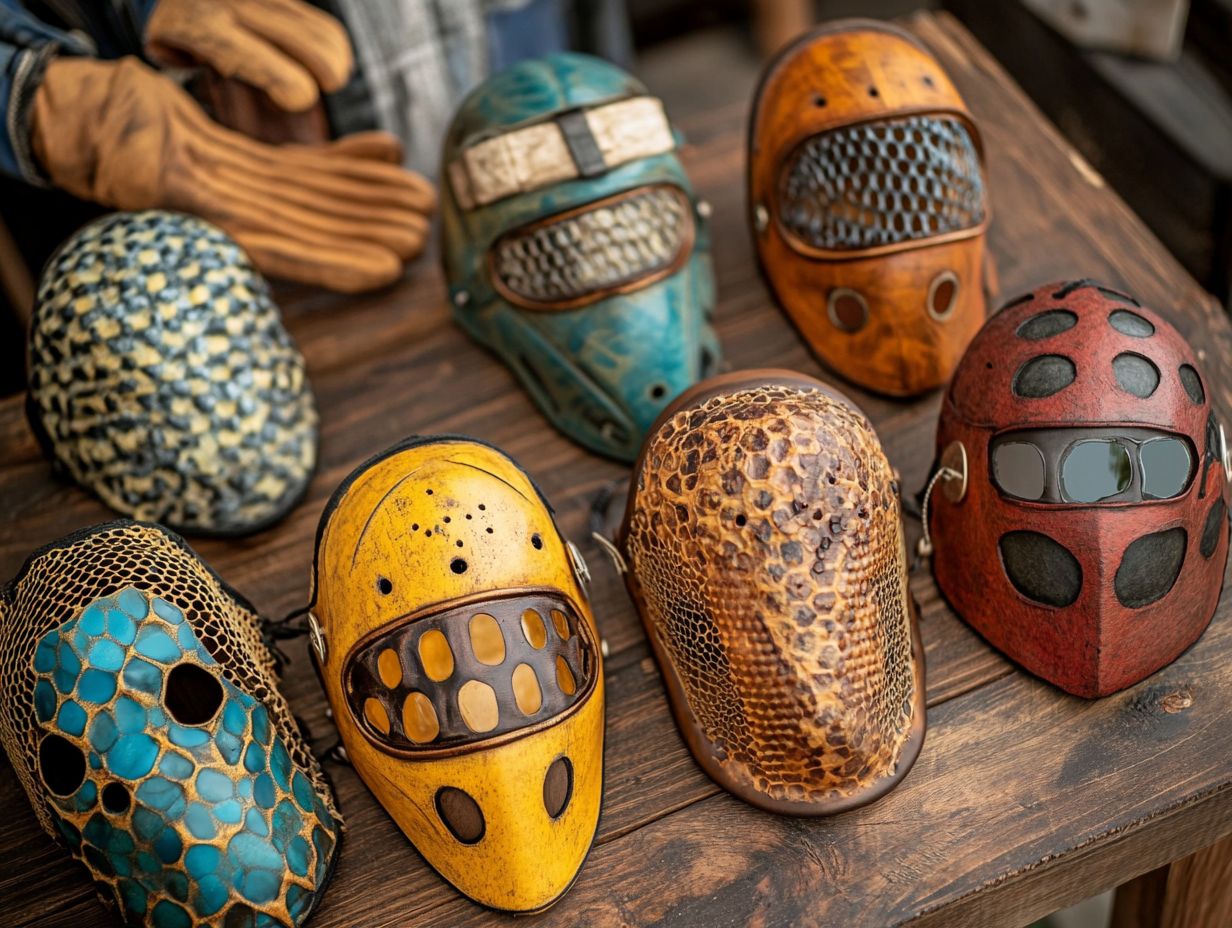
The material of your beekeeping mask is crucial for comfort and protection. Opting for lightweight, breathable fabrics is essential for those long hours spent with honeybees.
Different materials offer varying levels of safety and comfort, greatly influencing your overall beekeeping experience. Cotton and polyester blends are popular for their breathability and durability, though they can sometimes trap heat. In contrast, mesh materials excel in ventilation but may provide less protection against stings unless reinforced.
When working with chemicals like oxalic acid, ensure your mask provides adequate protection to avoid chemical burns. Some beekeeping masks have flexible plastic visors, which enhance visibility and contribute to your overall awareness and safety while tending to the hives. Ultimately, the choice of material affects your comfort and is critical for adequate protection against bee stings.
2. Visibility
Visibility plays a crucial role when selecting your beekeeping mask. Clear mesh panels significantly enhance your ability to observe bees and navigate hives without any obstructions.
This improved visibility allows you to monitor the bees behavior more effectively. It also helps you avoid potential stings and accidents that can arise when your sight is compromised.
For example, masks featuring wider mesh openings or made from lightweight and breathable materials typically provide better sightlines compared to those with denser fabric or tightly woven mesh that may obscure your vision.
Consider the sleek designs of modern bee suits, which often include nearly transparent face covers that allow for an unobstructed view. Such thoughtful design elements are essential for your overall safety, enabling you to concentrate on your tasks while staying aware of your surroundings crucial for nurturing a harmonious relationship with these industrious insects.
3. Ventilation
Good ventilation in beekeeping masks is essential for ensuring proper airflow. This prevents overheating and discomfort while you’re working with honeybees, especially on sweltering days.
This is especially important for beekeepers managing hives for long periods. Many modern mask designs now feature breathable mesh panels, strategically placed vents, and materials that help keep you dry that enhance airflow, allowing heat to escape and keeping you cool.
Such thoughtful design maximizes your comfort and directly impacts your ability to efficiently handle your colonies over long durations. When you can keep your focus on hive management instead of battling discomfort, your productivity and effectiveness soar.
Ensure your beekeeping equipment, including a hive tool and protective clothing, is designed with ventilation in mind. Opting for a mask that prioritizes ventilation is a key step toward achieving a more satisfying and successful beekeeping experience.
For beginners, beekeeping classes are a great way to learn more about the importance of mask ventilation and other essential beekeeping tools. Explore your options and find the perfect beekeeping mask today!
4. Comfort
When selecting a beekeeping mask, comfort is of utmost importance. An ill-fitting mask can distract you from your work and compromise your safety during hive inspections.
For beginning beekeepers, a beginner’s guide can provide valuable insights into choosing the right beekeeping clothing for both comfort and protection. Choose a well-designed mask with adjustable straps for the perfect fit that keeps you safe.
This design allows you to move freely without feeling restricted. It ensures that the mask effectively prevents bees from entering while helping you maintain focus on the task at hand.
Comfort significantly enhances your beekeeping experience, making it more enjoyable and considerably less stressful. When you can concentrate fully on your work without the annoyance of discomfort, you are better equipped to manage your hives safely and effectively.
This fosters a deeper connection with your bees and reduces the risk of accidents. An optimal beekeeping mask truly transforms the way you approach hive management and complements the rest of your beekeeping equipment, including essentials like a hive tool, smoker, and bee brush.
What Are the Safety Precautions When Wearing a Beekeeping Mask?
When you don a beekeeping mask, it’s essential to adhere to specific safety precautions to ensure you achieve maximum protection against honeybee stings and maintain a safe working environment. This is particularly important when using other protective clothing such as a beekeeping suit and beekeeper respirator.
- Ensure a proper fit.
- Secure the mask correctly.
- Commit to regular cleaning and maintenance.
These are pivotal steps that every beekeeper should embrace for optimal gear performance. By understanding and implementing these safety measures, not only will you safeguard yourself as a beginner following a comprehensive beginners guide, but you will also elevate your entire beekeeping experience.
1. Proper Fit
A proper fit is crucial for ensuring that your beekeeping mask provides the protection and comfort you need while working with bees. This includes handling additional equipment like a Bill Wood Comb Knife and American Smoker, which are essential for effective hive management.
When your mask is too loose or too tight, it can block your view and even allow bees to sneak inside. This can lead to stings and potential allergic reactions. A poorly fitting mask may become uncomfortable over time, creating distractions that jeopardize your focus during hive inspections.
By ensuring this essential piece of equipment is adjusted to fit securely, you significantly enhance your overall safety as a beekeeper. Therefore, investing time to find and maintain a good fit is vital, as it protects not only your well-being but also the health of your colonies.
2. Securing the Mask
Securing your beekeeping mask properly is essential to prevent it from shifting during hive inspections. A shifting mask could leave you vulnerable to bee stings.
A well-fastened mask keeps the protective mesh snug against your face and reduces the likelihood of unexpected encounters with bees. This attention to detail gives you peace of mind and enhances your overall safety while working closely with these industrious insects.
Choose masks with adjustable straps for a customized fit that accommodates various head sizes and shapes. Look for features like elastic bands or Velcro closures to keep the mask securely positioned, even during your swift movements. Make sure all your protective clothing, including beekeeping suits and respirators like the 3M model, fit well and are secure.
Don’t forget to regularly check the integrity of these fastening components to ensure they remain functional and effective. This keeps you safe as you tend to your buzzing charges. Also, consider replacing your respirator filters regularly for optimal protection.
3. Regular Cleaning and Maintenance
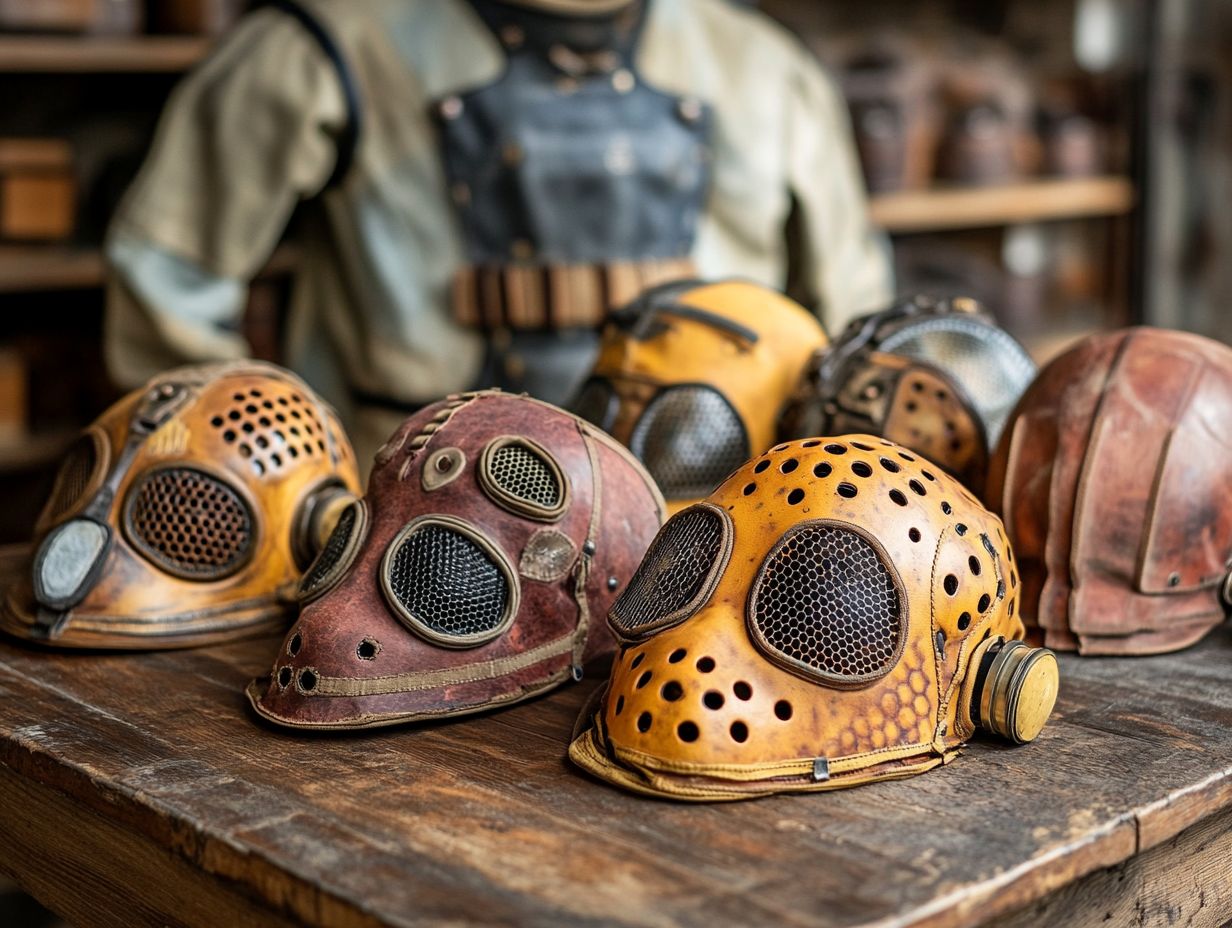
Regularly cleaning and maintaining your beekeeping mask is crucial for hygiene and extending the lifespan of your equipment. This is especially important when using high-quality gear like the X-plore 3300 or X-plore 5500, known for their durability.
Neglecting these essential practices risks the accumulation of dirt, wax, and even unwanted pests. This can compromise the functionality of your mask and your safety as a beekeeper. A well-maintained mask acts as a vital barrier against stings and potential diseases, allowing you to approach your hives with confidence.
For optimal results, make it a habit to rinse your mask with warm water and mild soap after each use. Ensure it dries completely before storing it away. Regularly inspecting the material for wear and tear will help prevent unforeseen accidents during bee handling. With effective maintenance, you can ensure that you remain protected and that your equipment functions efficiently.
How to Choose the Right Size Beekeeping Mask?
Selecting the right size of beekeeping mask is essential for your safety and comfort. An ill-fitting mask can impede your ability to work effectively with honeybees. To ensure you choose the appropriate size, take the time to measure your head accurately, consult the sizing chart provided by manufacturers, and try on various sizes if you have the opportunity.
This thorough approach will guide you in finding a mask that delivers both optimal protection and comfort while managing your hives.
1. Measure Your Head
Measuring your head correctly is the essential first step in selecting the perfect size of beekeeping mask. This ensures a snug yet comfortable fit. This process enhances your overall beekeeping experience and plays a pivotal role in safeguarding your safety while working with bees.
Start by gathering a flexible measuring tape. Wrap it around your head just above the eyebrows, ensuring it’s level all the way around. It s wise to take this measurement at least twice to confirm accuracy.
You might also want to measure the circumference of your forehead and the distance from your chin to just above your ears. These details will be invaluable in selecting a well-fitted mask.
Proper measurements significantly enhance the comfort of your protective gear, allowing you to immerse yourself in your beekeeping tasks without distractions.
Start measuring your head today to find the perfect fit!
2. Check the Sizing Chart
Once you ve measured your head, the next step is to consult the sizing chart provided by the manufacturer to find a beekeeping mask that fits you perfectly. Understanding the sizing chart is essential, as it includes specific measurements that ensure a snug fit.
A well-fitting beekeeping mask boosts your comfort and significantly enhances your safety while you re tending to the apiary. By following the manufacturer s guidelines, you can avoid potential mishaps from a mask that s too loose or too tight, which could interfere with your visibility or movement.
Pay close attention to these details to ensure you can work confidently and safely! Additionally, using advanced technologies like sublimation can enhance both the look and function of these masks.
3. Try on Different Sizes
Trying on different sizes of beekeeping masks is crucial to find the perfect fit, as sizes can vary significantly between manufacturers and models. This process ensures your comfort and enables you to adequately protect yourself while working with bees.
Wearing a mask that fits well helps prevent bee stings and enhances your visibility, which is vital for effective beekeeping. By experimenting with various styles and sizes, you can discover which design offers the ideal combination of protection and comfort tailored to your unique needs.
Comparing different options gives you a stronger sense of personal safety, as each mask may come with distinct features for specific environments or hive conditions. This is particularly important when considering specialized equipment for Varroa treatment, a common pest problem in beekeeping, such as using Oxalic Acid or Formic Acid.
What Are the Best Materials for a Beekeeping Mask?
Selecting the appropriate material for your beekeeping mask is essential for ensuring your safety, comfort, and durability while tending to your honeybees.
The finest materials include cotton, synthetic blends, mesh, and plastic, each presenting distinct advantages and protection against bee stings. By familiarizing yourself with these materials, you can choose a beekeeping mask that not only meets your needs but also enhances your overall beekeeping setup.
For beginners, consider investing in comprehensive beekeeping starter kits for a complete gear solution.
1. Cotton
Cotton beekeeping masks are breathable and comfortable, perfect for long hours with bees. They allow airflow, reducing the risk of overheating in warmer months.
The softness of cotton significantly enhances your comfort, enabling you to focus on your tasks without distractions. Masks made from high-quality cotton can also undergo the sublimation process to add personalized designs or logos, enhancing your beekeeping experience.
Many cotton masks feature reinforced stitching and elastic straps that ensure a secure fit, enhancing safety by preventing gaps where bees might sneak in. The natural fibers are less irritating to your skin, a considerable advantage if you have sensitive skin.
With all these features combined, you can create a safer and more enjoyable beekeeping experience.
2. Synthetic Blends
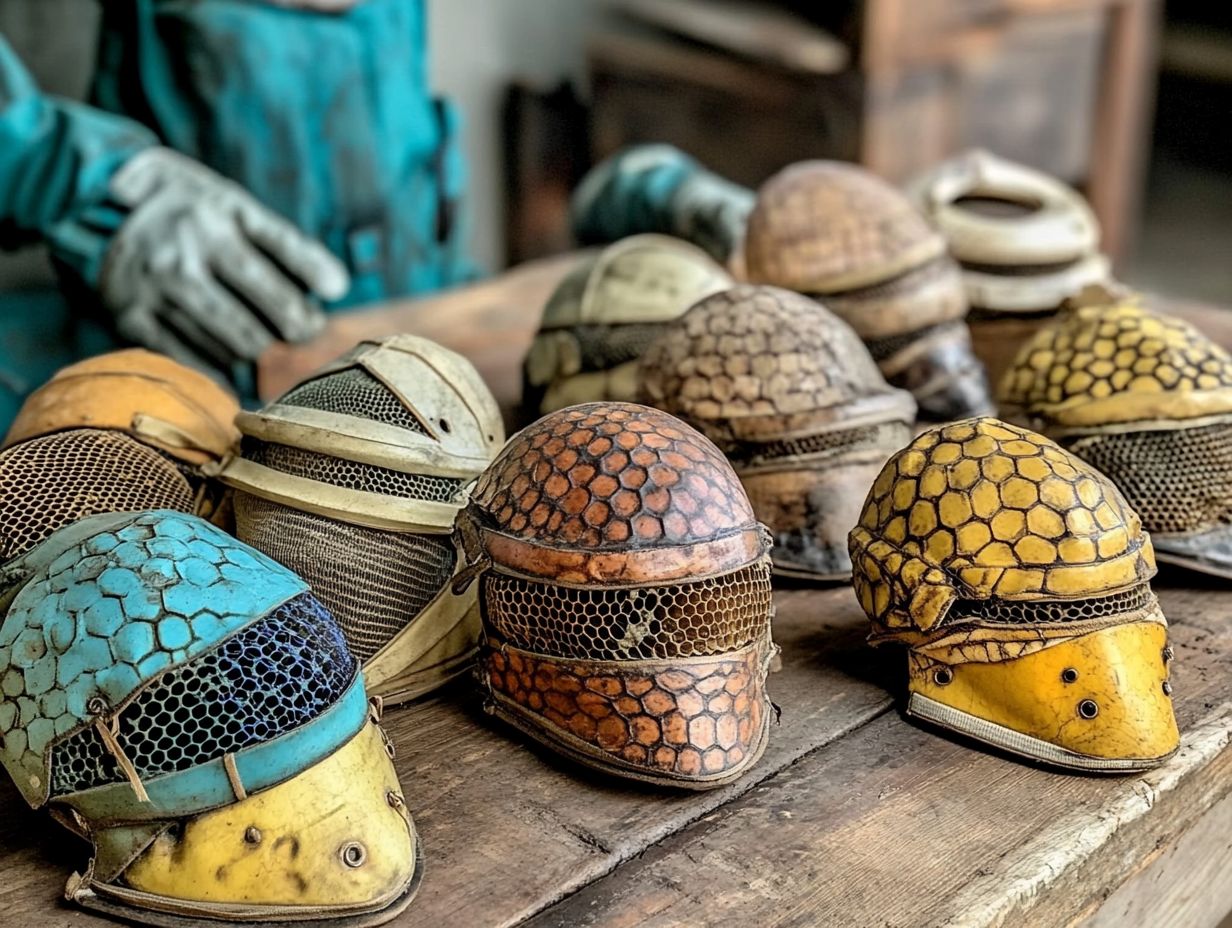
Synthetic blends used in beekeeping masks deliver exceptional durability and lightweight properties. They are an ideal choice for beekeepers who want long-lasting protective gear.
These advanced materials can withstand the rigors of outdoor activities while providing comfort. The breathable nature of these synthetic blends helps regulate temperature and moisture, allowing you to wear them for extended periods without discomfort.
This blend of strength and comfort is essential when working close to hives, where safety is crucial. The lightweight design ensures these masks won t hinder your vision or mobility.
You can operate efficiently while staying protected from stings and other hazards. It’s a crucial part of your beekeeping equipment that ensures safety and comfort.
3. Mesh and Beekeeper Respirators
Mesh beekeeping masks offer exceptional ventilation and visibility, making them ideal for warm climates or extensive hive inspections. Pairing them with a beekeeper respirator provides extra protection against airborne particles.
The lightweight mesh materials ensure optimal airflow, significantly reducing the risk of overheating during long hours in the apiary.
These masks enhance visibility, allowing you to see your surroundings and monitor hive activity without obstructions. This combination of features boosts your comfort and promotes a safer working environment.
Minimizing the likelihood of accidents while handling bees allows you to concentrate fully on your tasks, ultimately fostering healthier hives. Don’t forget to consider additional protective clothing like a beekeeping suit for full-body protection.
4. Plastic and Duraflow Masks
Plastic beekeeping masks and Duraflow Masks provide robust protection and impressive durability, making them ideal for environments with heavy bee activity.
These masks create an essential barrier against bee stings, especially during the bustling spring and summer months when bee populations peak. Their lightweight and breathable design ensures comfort during long hours in the field.
This feature is invaluable for professional beekeepers managing multiple hives. Using these masks along with a Hive Tool (a tool used to manipulate frames in the hive) and Smoker (a device that produces smoke to calm bees) can enhance your beekeeping experience.
When faced with aggressive bee behavior during hive inspections, plastic masks provide the added reassurance you need. Their resistance to wear and tear guarantees longevity, making them a smart investment for anyone passionate about beekeeping.
Watch our video for essential tips and consider enrolling in beekeeping classes to enhance your skills!
Frequently Asked Questions
What should I consider when choosing my beekeeping gear?
When choosing a beekeeping mask and other beekeeping equipment, consider factors like the type of beekeeping, the level of protection needed, the fit and comfort of the mask, the material, and additional items like a Bee brush and Bill Wood Comb Knife for easier hive management.
Which type of beekeeping mask and starter kits are best for beginners?
For beginners, a basic veil-style mask with a wide brim and mesh veil is usually sufficient. It provides good protection while being affordable and easy to use.
You might also want to consider Beekeeping Starter Kits that include essential tools and protective gear to help you get started.
Do I need to wear a beekeeping mask and other protective clothing if I am just checking on my beehive?
It is always recommended to wear a beekeeping mask whenever you are near your beehive, even if you are just checking on them. Bees can become agitated and protective of their hive at any time, so it’s important to have proper protection.
A beekeeping suit and other protective clothing can further safeguard you in such situations.
What level of protection does a beekeeping mask provide?
A beekeeping mask protects your face, neck, and head from bee stings. It does not cover your entire body, so wearing a beekeeping suit is essential when working with bees.
Should I choose a beekeeping mask with a plastic or wire frame, and what about respirators?
Plastic frames are lightweight and comfortable, while wire frames offer sturdiness. Choose based on your comfort and preference.
Consider using a 3M or X-plore 5500 respirator with respirator filters. These can help protect you from dust and chemicals in the apiary.
How do I ensure the best fit for my beekeeping mask and other protective equipment?
Try on the beekeeping mask before you buy it. It should fit snugly but not too tight, with the veil at least 10 inches from your face.
Adjust the straps for a custom fit. Make sure your respirator fits well with the necessary respirator filters for your environment.

